BAO 3309: Analysis of the Conceptual Framework for Reporting
VerifiedAdded on 2023/06/07
|13
|3560
|255
Report
AI Summary
This report provides a detailed review and analysis of the Conceptual Framework for Financial Reporting, as revised by the International Accounting Standards Board (IASB). It begins by defining the conceptual framework and its purposes, emphasizing its role in guiding the development and application of IFRS standards. The report discusses key aspects such as measurement bases for assets and liabilities, including historical cost and fair value, and how these are applied to current and non-current assets. It also addresses the presentation and disclosure of financial information, highlighting revisions made by the IASB to improve clarity and relevance. Furthermore, the report examines the definitions of assets and liabilities, recognition criteria, and the importance of stewardship and prudence in financial reporting. It concludes by considering factors influencing the selection of measurement bases and the classification of income and expenses, offering a comprehensive overview of the framework's key components and revisions. Desklib provides this document and many other solved assignments for students.
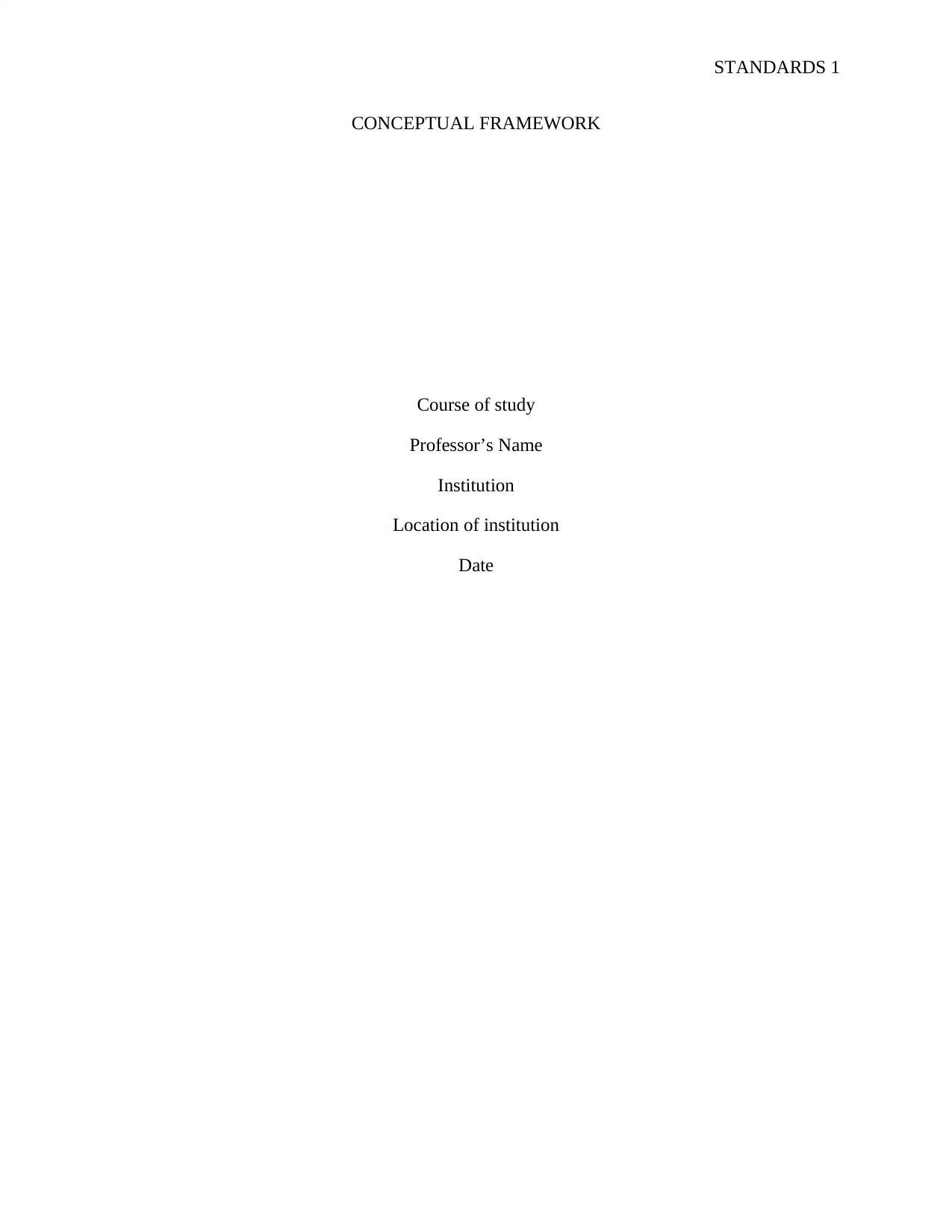
STANDARDS 1
CONCEPTUAL FRAMEWORK
Course of study
Professor’s Name
Institution
Location of institution
Date
CONCEPTUAL FRAMEWORK
Course of study
Professor’s Name
Institution
Location of institution
Date
Paraphrase This Document
Need a fresh take? Get an instant paraphrase of this document with our AI Paraphraser
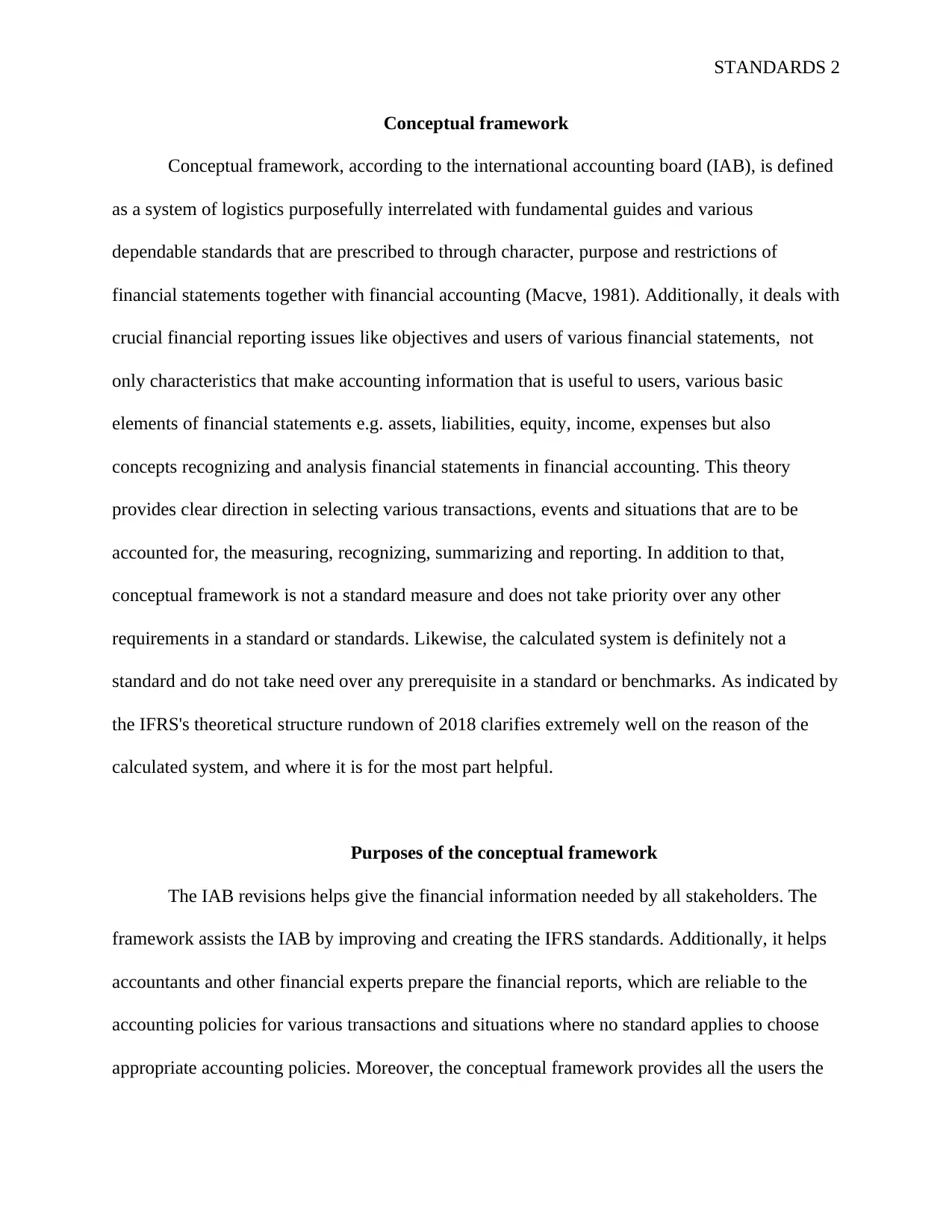
STANDARDS 2
Conceptual framework
Conceptual framework, according to the international accounting board (IAB), is defined
as a system of logistics purposefully interrelated with fundamental guides and various
dependable standards that are prescribed to through character, purpose and restrictions of
financial statements together with financial accounting (Macve, 1981). Additionally, it deals with
crucial financial reporting issues like objectives and users of various financial statements, not
only characteristics that make accounting information that is useful to users, various basic
elements of financial statements e.g. assets, liabilities, equity, income, expenses but also
concepts recognizing and analysis financial statements in financial accounting. This theory
provides clear direction in selecting various transactions, events and situations that are to be
accounted for, the measuring, recognizing, summarizing and reporting. In addition to that,
conceptual framework is not a standard measure and does not take priority over any other
requirements in a standard or standards. Likewise, the calculated system is definitely not a
standard and do not take need over any prerequisite in a standard or benchmarks. As indicated by
the IFRS's theoretical structure rundown of 2018 clarifies extremely well on the reason of the
calculated system, and where it is for the most part helpful.
Purposes of the conceptual framework
The IAB revisions helps give the financial information needed by all stakeholders. The
framework assists the IAB by improving and creating the IFRS standards. Additionally, it helps
accountants and other financial experts prepare the financial reports, which are reliable to the
accounting policies for various transactions and situations where no standard applies to choose
appropriate accounting policies. Moreover, the conceptual framework provides all the users the
Conceptual framework
Conceptual framework, according to the international accounting board (IAB), is defined
as a system of logistics purposefully interrelated with fundamental guides and various
dependable standards that are prescribed to through character, purpose and restrictions of
financial statements together with financial accounting (Macve, 1981). Additionally, it deals with
crucial financial reporting issues like objectives and users of various financial statements, not
only characteristics that make accounting information that is useful to users, various basic
elements of financial statements e.g. assets, liabilities, equity, income, expenses but also
concepts recognizing and analysis financial statements in financial accounting. This theory
provides clear direction in selecting various transactions, events and situations that are to be
accounted for, the measuring, recognizing, summarizing and reporting. In addition to that,
conceptual framework is not a standard measure and does not take priority over any other
requirements in a standard or standards. Likewise, the calculated system is definitely not a
standard and do not take need over any prerequisite in a standard or benchmarks. As indicated by
the IFRS's theoretical structure rundown of 2018 clarifies extremely well on the reason of the
calculated system, and where it is for the most part helpful.
Purposes of the conceptual framework
The IAB revisions helps give the financial information needed by all stakeholders. The
framework assists the IAB by improving and creating the IFRS standards. Additionally, it helps
accountants and other financial experts prepare the financial reports, which are reliable to the
accounting policies for various transactions and situations where no standard applies to choose
appropriate accounting policies. Moreover, the conceptual framework provides all the users the
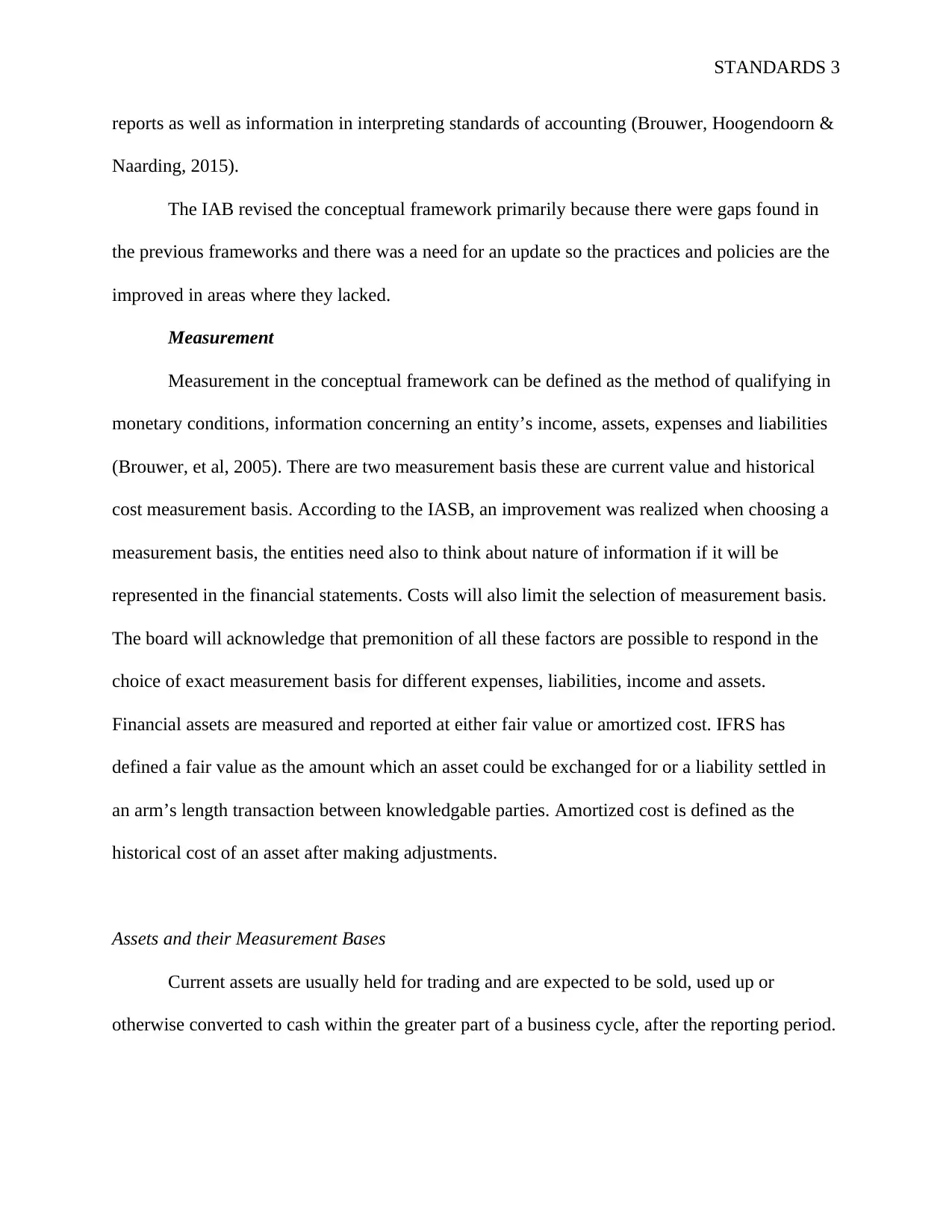
STANDARDS 3
reports as well as information in interpreting standards of accounting (Brouwer, Hoogendoorn &
Naarding, 2015).
The IAB revised the conceptual framework primarily because there were gaps found in
the previous frameworks and there was a need for an update so the practices and policies are the
improved in areas where they lacked.
Measurement
Measurement in the conceptual framework can be defined as the method of qualifying in
monetary conditions, information concerning an entity’s income, assets, expenses and liabilities
(Brouwer, et al, 2005). There are two measurement basis these are current value and historical
cost measurement basis. According to the IASB, an improvement was realized when choosing a
measurement basis, the entities need also to think about nature of information if it will be
represented in the financial statements. Costs will also limit the selection of measurement basis.
The board will acknowledge that premonition of all these factors are possible to respond in the
choice of exact measurement basis for different expenses, liabilities, income and assets.
Financial assets are measured and reported at either fair value or amortized cost. IFRS has
defined a fair value as the amount which an asset could be exchanged for or a liability settled in
an arm’s length transaction between knowledgable parties. Amortized cost is defined as the
historical cost of an asset after making adjustments.
Assets and their Measurement Bases
Current assets are usually held for trading and are expected to be sold, used up or
otherwise converted to cash within the greater part of a business cycle, after the reporting period.
reports as well as information in interpreting standards of accounting (Brouwer, Hoogendoorn &
Naarding, 2015).
The IAB revised the conceptual framework primarily because there were gaps found in
the previous frameworks and there was a need for an update so the practices and policies are the
improved in areas where they lacked.
Measurement
Measurement in the conceptual framework can be defined as the method of qualifying in
monetary conditions, information concerning an entity’s income, assets, expenses and liabilities
(Brouwer, et al, 2005). There are two measurement basis these are current value and historical
cost measurement basis. According to the IASB, an improvement was realized when choosing a
measurement basis, the entities need also to think about nature of information if it will be
represented in the financial statements. Costs will also limit the selection of measurement basis.
The board will acknowledge that premonition of all these factors are possible to respond in the
choice of exact measurement basis for different expenses, liabilities, income and assets.
Financial assets are measured and reported at either fair value or amortized cost. IFRS has
defined a fair value as the amount which an asset could be exchanged for or a liability settled in
an arm’s length transaction between knowledgable parties. Amortized cost is defined as the
historical cost of an asset after making adjustments.
Assets and their Measurement Bases
Current assets are usually held for trading and are expected to be sold, used up or
otherwise converted to cash within the greater part of a business cycle, after the reporting period.
⊘ This is a preview!⊘
Do you want full access?
Subscribe today to unlock all pages.

Trusted by 1+ million students worldwide
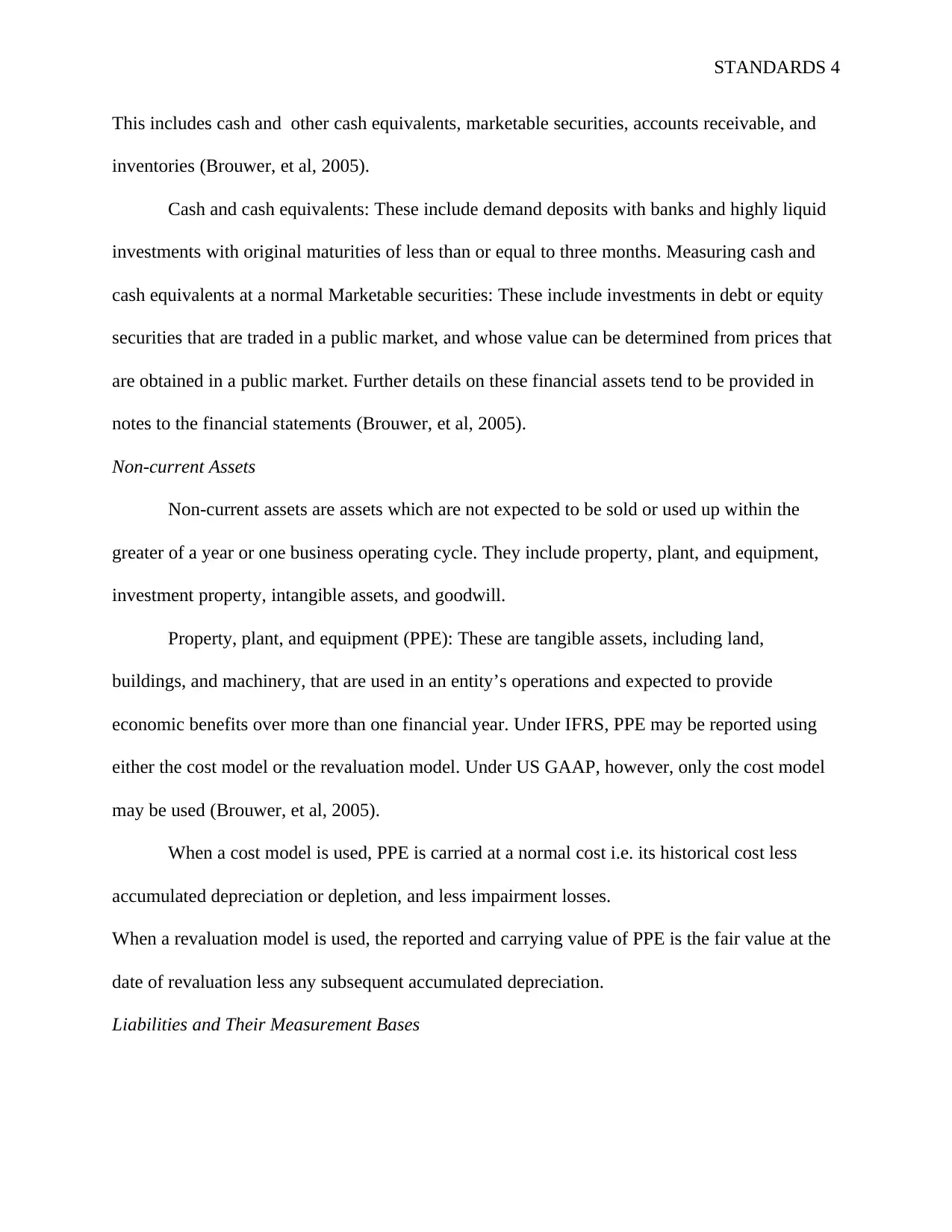
STANDARDS 4
This includes cash and other cash equivalents, marketable securities, accounts receivable, and
inventories (Brouwer, et al, 2005).
Cash and cash equivalents: These include demand deposits with banks and highly liquid
investments with original maturities of less than or equal to three months. Measuring cash and
cash equivalents at a normal Marketable securities: These include investments in debt or equity
securities that are traded in a public market, and whose value can be determined from prices that
are obtained in a public market. Further details on these financial assets tend to be provided in
notes to the financial statements (Brouwer, et al, 2005).
Non-current Assets
Non-current assets are assets which are not expected to be sold or used up within the
greater of a year or one business operating cycle. They include property, plant, and equipment,
investment property, intangible assets, and goodwill.
Property, plant, and equipment (PPE): These are tangible assets, including land,
buildings, and machinery, that are used in an entity’s operations and expected to provide
economic benefits over more than one financial year. Under IFRS, PPE may be reported using
either the cost model or the revaluation model. Under US GAAP, however, only the cost model
may be used (Brouwer, et al, 2005).
When a cost model is used, PPE is carried at a normal cost i.e. its historical cost less
accumulated depreciation or depletion, and less impairment losses.
When a revaluation model is used, the reported and carrying value of PPE is the fair value at the
date of revaluation less any subsequent accumulated depreciation.
Liabilities and Their Measurement Bases
This includes cash and other cash equivalents, marketable securities, accounts receivable, and
inventories (Brouwer, et al, 2005).
Cash and cash equivalents: These include demand deposits with banks and highly liquid
investments with original maturities of less than or equal to three months. Measuring cash and
cash equivalents at a normal Marketable securities: These include investments in debt or equity
securities that are traded in a public market, and whose value can be determined from prices that
are obtained in a public market. Further details on these financial assets tend to be provided in
notes to the financial statements (Brouwer, et al, 2005).
Non-current Assets
Non-current assets are assets which are not expected to be sold or used up within the
greater of a year or one business operating cycle. They include property, plant, and equipment,
investment property, intangible assets, and goodwill.
Property, plant, and equipment (PPE): These are tangible assets, including land,
buildings, and machinery, that are used in an entity’s operations and expected to provide
economic benefits over more than one financial year. Under IFRS, PPE may be reported using
either the cost model or the revaluation model. Under US GAAP, however, only the cost model
may be used (Brouwer, et al, 2005).
When a cost model is used, PPE is carried at a normal cost i.e. its historical cost less
accumulated depreciation or depletion, and less impairment losses.
When a revaluation model is used, the reported and carrying value of PPE is the fair value at the
date of revaluation less any subsequent accumulated depreciation.
Liabilities and Their Measurement Bases
Paraphrase This Document
Need a fresh take? Get an instant paraphrase of this document with our AI Paraphraser
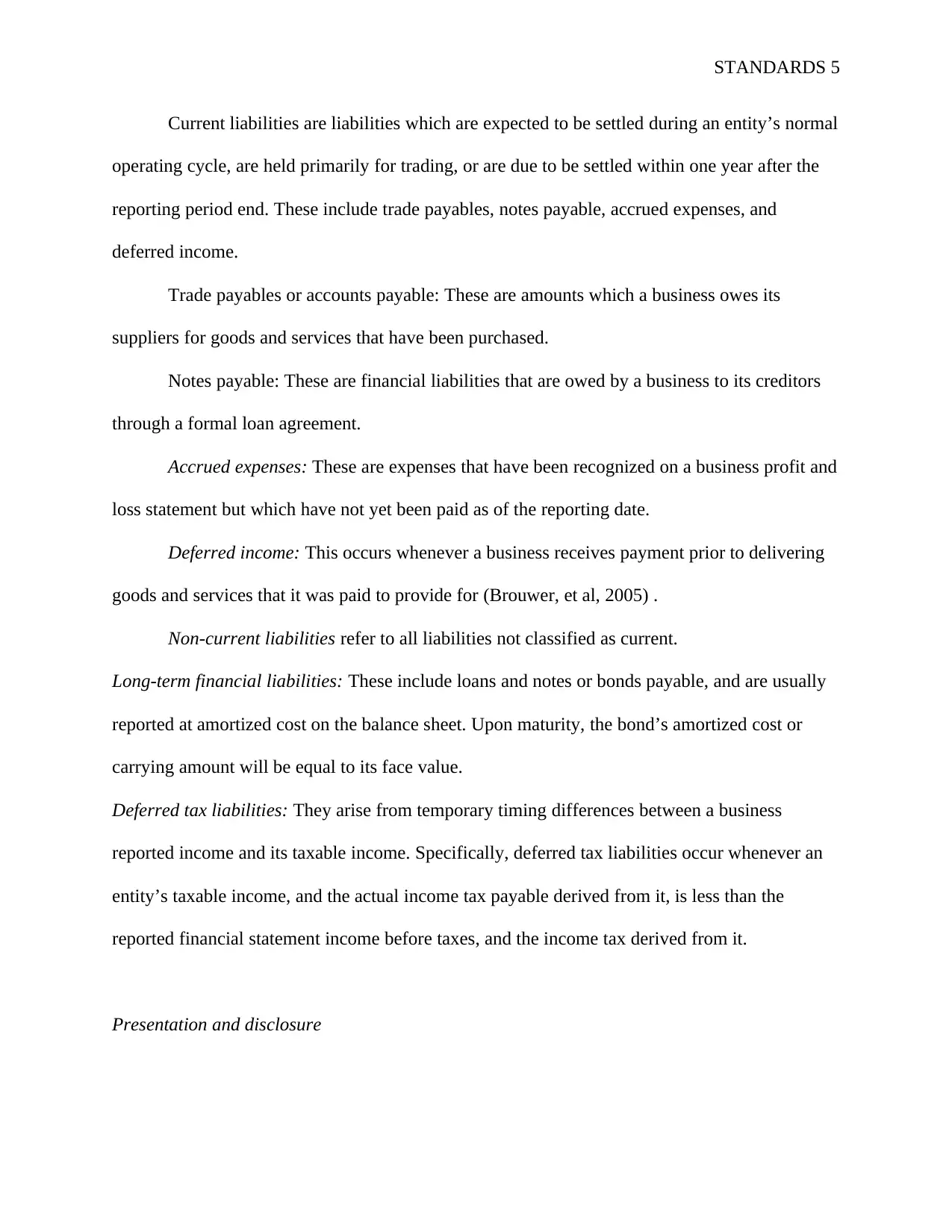
STANDARDS 5
Current liabilities are liabilities which are expected to be settled during an entity’s normal
operating cycle, are held primarily for trading, or are due to be settled within one year after the
reporting period end. These include trade payables, notes payable, accrued expenses, and
deferred income.
Trade payables or accounts payable: These are amounts which a business owes its
suppliers for goods and services that have been purchased.
Notes payable: These are financial liabilities that are owed by a business to its creditors
through a formal loan agreement.
Accrued expenses: These are expenses that have been recognized on a business profit and
loss statement but which have not yet been paid as of the reporting date.
Deferred income: This occurs whenever a business receives payment prior to delivering
goods and services that it was paid to provide for (Brouwer, et al, 2005) .
Non-current liabilities refer to all liabilities not classified as current.
Long-term financial liabilities: These include loans and notes or bonds payable, and are usually
reported at amortized cost on the balance sheet. Upon maturity, the bond’s amortized cost or
carrying amount will be equal to its face value.
Deferred tax liabilities: They arise from temporary timing differences between a business
reported income and its taxable income. Specifically, deferred tax liabilities occur whenever an
entity’s taxable income, and the actual income tax payable derived from it, is less than the
reported financial statement income before taxes, and the income tax derived from it.
Presentation and disclosure
Current liabilities are liabilities which are expected to be settled during an entity’s normal
operating cycle, are held primarily for trading, or are due to be settled within one year after the
reporting period end. These include trade payables, notes payable, accrued expenses, and
deferred income.
Trade payables or accounts payable: These are amounts which a business owes its
suppliers for goods and services that have been purchased.
Notes payable: These are financial liabilities that are owed by a business to its creditors
through a formal loan agreement.
Accrued expenses: These are expenses that have been recognized on a business profit and
loss statement but which have not yet been paid as of the reporting date.
Deferred income: This occurs whenever a business receives payment prior to delivering
goods and services that it was paid to provide for (Brouwer, et al, 2005) .
Non-current liabilities refer to all liabilities not classified as current.
Long-term financial liabilities: These include loans and notes or bonds payable, and are usually
reported at amortized cost on the balance sheet. Upon maturity, the bond’s amortized cost or
carrying amount will be equal to its face value.
Deferred tax liabilities: They arise from temporary timing differences between a business
reported income and its taxable income. Specifically, deferred tax liabilities occur whenever an
entity’s taxable income, and the actual income tax payable derived from it, is less than the
reported financial statement income before taxes, and the income tax derived from it.
Presentation and disclosure
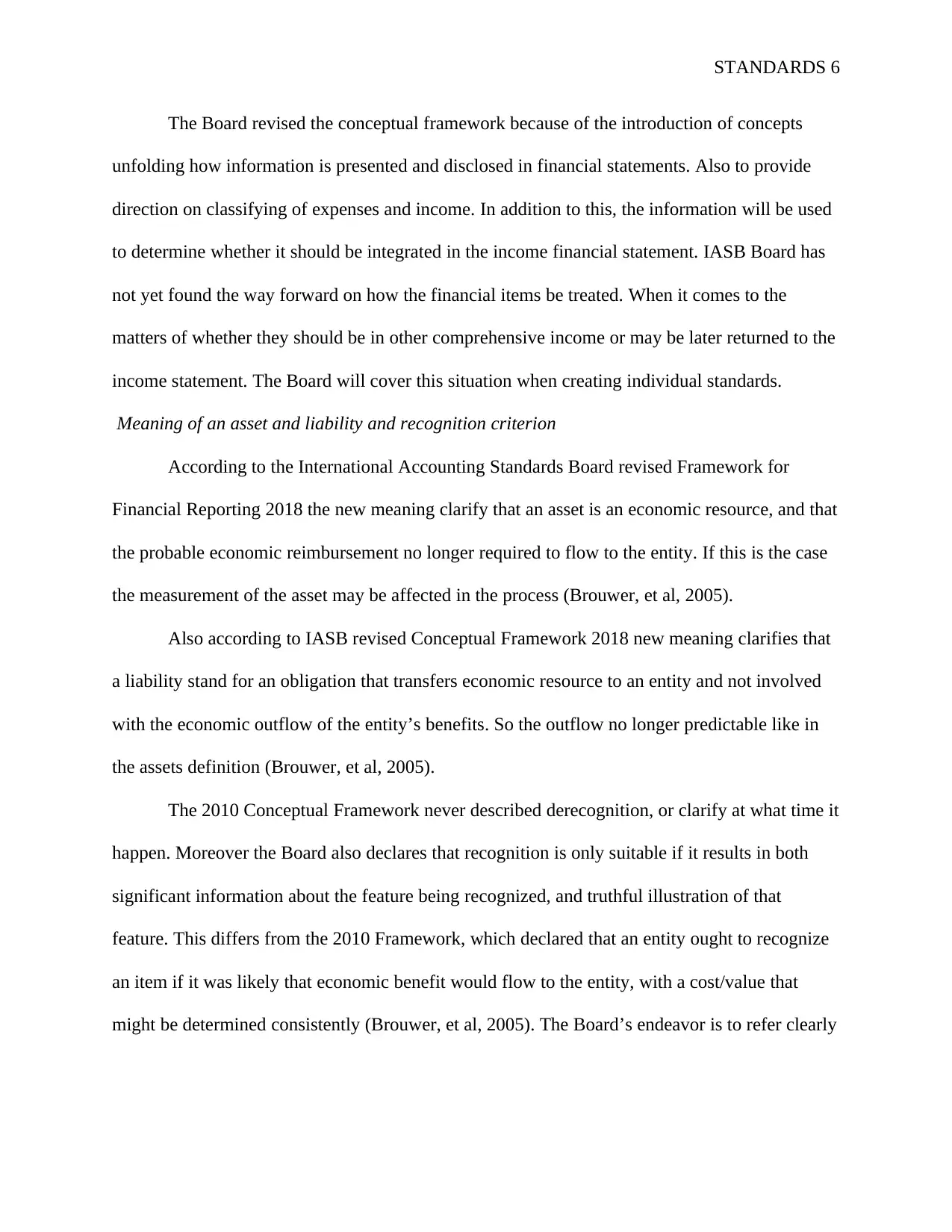
STANDARDS 6
The Board revised the conceptual framework because of the introduction of concepts
unfolding how information is presented and disclosed in financial statements. Also to provide
direction on classifying of expenses and income. In addition to this, the information will be used
to determine whether it should be integrated in the income financial statement. IASB Board has
not yet found the way forward on how the financial items be treated. When it comes to the
matters of whether they should be in other comprehensive income or may be later returned to the
income statement. The Board will cover this situation when creating individual standards.
Meaning of an asset and liability and recognition criterion
According to the International Accounting Standards Board revised Framework for
Financial Reporting 2018 the new meaning clarify that an asset is an economic resource, and that
the probable economic reimbursement no longer required to flow to the entity. If this is the case
the measurement of the asset may be affected in the process (Brouwer, et al, 2005).
Also according to IASB revised Conceptual Framework 2018 new meaning clarifies that
a liability stand for an obligation that transfers economic resource to an entity and not involved
with the economic outflow of the entity’s benefits. So the outflow no longer predictable like in
the assets definition (Brouwer, et al, 2005).
The 2010 Conceptual Framework never described derecognition, or clarify at what time it
happen. Moreover the Board also declares that recognition is only suitable if it results in both
significant information about the feature being recognized, and truthful illustration of that
feature. This differs from the 2010 Framework, which declared that an entity ought to recognize
an item if it was likely that economic benefit would flow to the entity, with a cost/value that
might be determined consistently (Brouwer, et al, 2005). The Board’s endeavor is to refer clearly
The Board revised the conceptual framework because of the introduction of concepts
unfolding how information is presented and disclosed in financial statements. Also to provide
direction on classifying of expenses and income. In addition to this, the information will be used
to determine whether it should be integrated in the income financial statement. IASB Board has
not yet found the way forward on how the financial items be treated. When it comes to the
matters of whether they should be in other comprehensive income or may be later returned to the
income statement. The Board will cover this situation when creating individual standards.
Meaning of an asset and liability and recognition criterion
According to the International Accounting Standards Board revised Framework for
Financial Reporting 2018 the new meaning clarify that an asset is an economic resource, and that
the probable economic reimbursement no longer required to flow to the entity. If this is the case
the measurement of the asset may be affected in the process (Brouwer, et al, 2005).
Also according to IASB revised Conceptual Framework 2018 new meaning clarifies that
a liability stand for an obligation that transfers economic resource to an entity and not involved
with the economic outflow of the entity’s benefits. So the outflow no longer predictable like in
the assets definition (Brouwer, et al, 2005).
The 2010 Conceptual Framework never described derecognition, or clarify at what time it
happen. Moreover the Board also declares that recognition is only suitable if it results in both
significant information about the feature being recognized, and truthful illustration of that
feature. This differs from the 2010 Framework, which declared that an entity ought to recognize
an item if it was likely that economic benefit would flow to the entity, with a cost/value that
might be determined consistently (Brouwer, et al, 2005). The Board’s endeavor is to refer clearly
⊘ This is a preview!⊘
Do you want full access?
Subscribe today to unlock all pages.

Trusted by 1+ million students worldwide
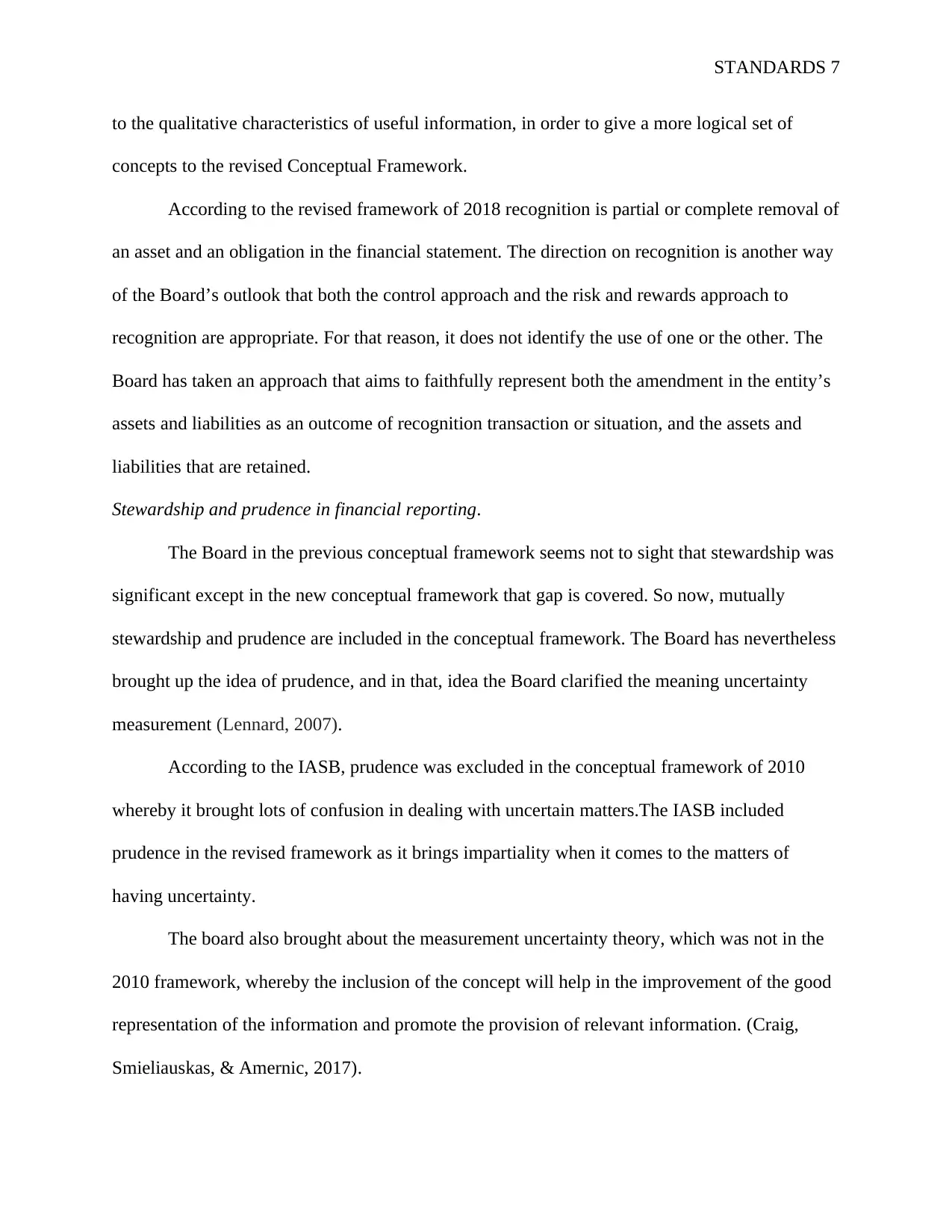
STANDARDS 7
to the qualitative characteristics of useful information, in order to give a more logical set of
concepts to the revised Conceptual Framework.
According to the revised framework of 2018 recognition is partial or complete removal of
an asset and an obligation in the financial statement. The direction on recognition is another way
of the Board’s outlook that both the control approach and the risk and rewards approach to
recognition are appropriate. For that reason, it does not identify the use of one or the other. The
Board has taken an approach that aims to faithfully represent both the amendment in the entity’s
assets and liabilities as an outcome of recognition transaction or situation, and the assets and
liabilities that are retained.
Stewardship and prudence in financial reporting.
The Board in the previous conceptual framework seems not to sight that stewardship was
significant except in the new conceptual framework that gap is covered. So now, mutually
stewardship and prudence are included in the conceptual framework. The Board has nevertheless
brought up the idea of prudence, and in that, idea the Board clarified the meaning uncertainty
measurement (Lennard, 2007).
According to the IASB, prudence was excluded in the conceptual framework of 2010
whereby it brought lots of confusion in dealing with uncertain matters.The IASB included
prudence in the revised framework as it brings impartiality when it comes to the matters of
having uncertainty.
The board also brought about the measurement uncertainty theory, which was not in the
2010 framework, whereby the inclusion of the concept will help in the improvement of the good
representation of the information and promote the provision of relevant information. (Craig,
Smieliauskas, & Amernic, 2017).
to the qualitative characteristics of useful information, in order to give a more logical set of
concepts to the revised Conceptual Framework.
According to the revised framework of 2018 recognition is partial or complete removal of
an asset and an obligation in the financial statement. The direction on recognition is another way
of the Board’s outlook that both the control approach and the risk and rewards approach to
recognition are appropriate. For that reason, it does not identify the use of one or the other. The
Board has taken an approach that aims to faithfully represent both the amendment in the entity’s
assets and liabilities as an outcome of recognition transaction or situation, and the assets and
liabilities that are retained.
Stewardship and prudence in financial reporting.
The Board in the previous conceptual framework seems not to sight that stewardship was
significant except in the new conceptual framework that gap is covered. So now, mutually
stewardship and prudence are included in the conceptual framework. The Board has nevertheless
brought up the idea of prudence, and in that, idea the Board clarified the meaning uncertainty
measurement (Lennard, 2007).
According to the IASB, prudence was excluded in the conceptual framework of 2010
whereby it brought lots of confusion in dealing with uncertain matters.The IASB included
prudence in the revised framework as it brings impartiality when it comes to the matters of
having uncertainty.
The board also brought about the measurement uncertainty theory, which was not in the
2010 framework, whereby the inclusion of the concept will help in the improvement of the good
representation of the information and promote the provision of relevant information. (Craig,
Smieliauskas, & Amernic, 2017).
Paraphrase This Document
Need a fresh take? Get an instant paraphrase of this document with our AI Paraphraser
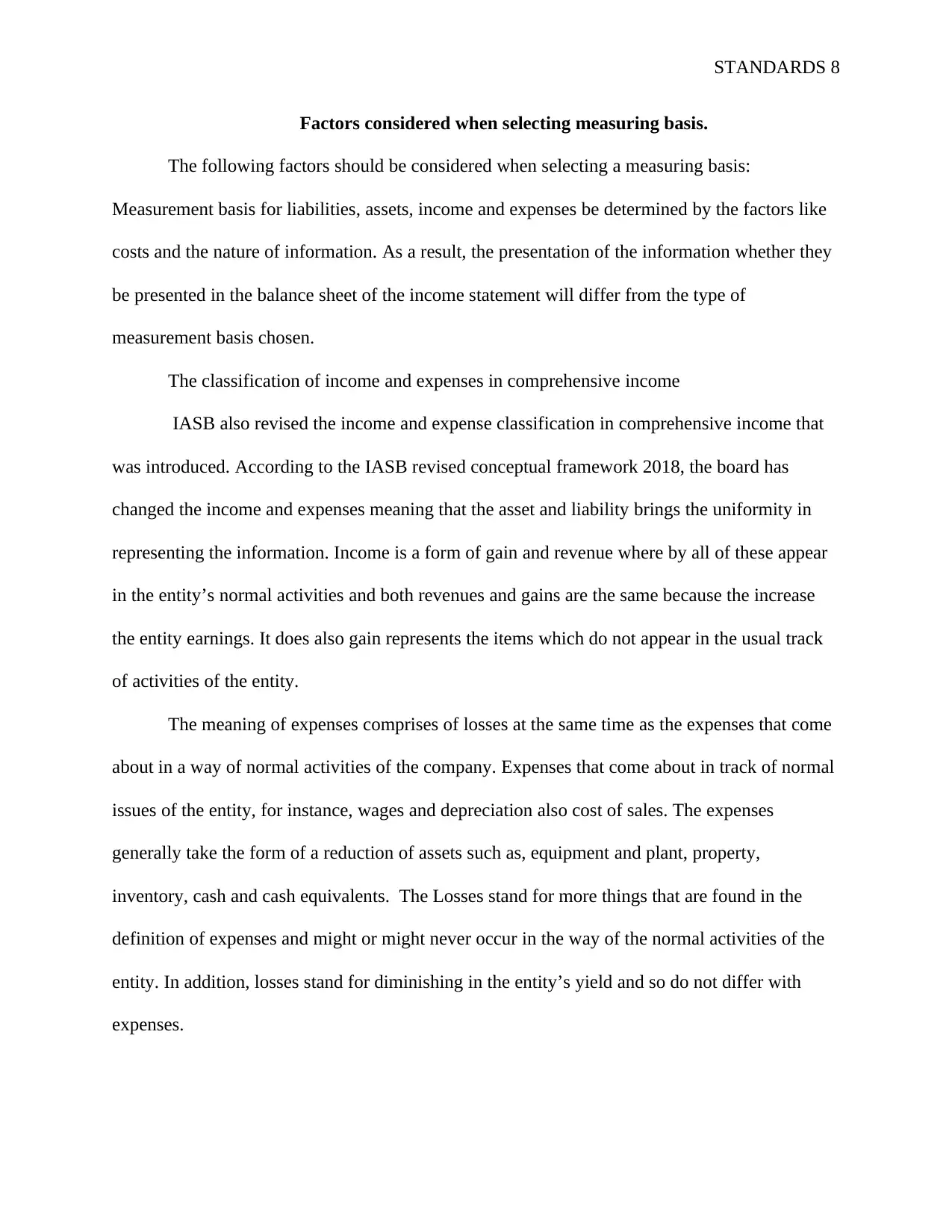
STANDARDS 8
Factors considered when selecting measuring basis.
The following factors should be considered when selecting a measuring basis:
Measurement basis for liabilities, assets, income and expenses be determined by the factors like
costs and the nature of information. As a result, the presentation of the information whether they
be presented in the balance sheet of the income statement will differ from the type of
measurement basis chosen.
The classification of income and expenses in comprehensive income
IASB also revised the income and expense classification in comprehensive income that
was introduced. According to the IASB revised conceptual framework 2018, the board has
changed the income and expenses meaning that the asset and liability brings the uniformity in
representing the information. Income is a form of gain and revenue where by all of these appear
in the entity’s normal activities and both revenues and gains are the same because the increase
the entity earnings. It does also gain represents the items which do not appear in the usual track
of activities of the entity.
The meaning of expenses comprises of losses at the same time as the expenses that come
about in a way of normal activities of the company. Expenses that come about in track of normal
issues of the entity, for instance, wages and depreciation also cost of sales. The expenses
generally take the form of a reduction of assets such as, equipment and plant, property,
inventory, cash and cash equivalents. The Losses stand for more things that are found in the
definition of expenses and might or might never occur in the way of the normal activities of the
entity. In addition, losses stand for diminishing in the entity’s yield and so do not differ with
expenses.
Factors considered when selecting measuring basis.
The following factors should be considered when selecting a measuring basis:
Measurement basis for liabilities, assets, income and expenses be determined by the factors like
costs and the nature of information. As a result, the presentation of the information whether they
be presented in the balance sheet of the income statement will differ from the type of
measurement basis chosen.
The classification of income and expenses in comprehensive income
IASB also revised the income and expense classification in comprehensive income that
was introduced. According to the IASB revised conceptual framework 2018, the board has
changed the income and expenses meaning that the asset and liability brings the uniformity in
representing the information. Income is a form of gain and revenue where by all of these appear
in the entity’s normal activities and both revenues and gains are the same because the increase
the entity earnings. It does also gain represents the items which do not appear in the usual track
of activities of the entity.
The meaning of expenses comprises of losses at the same time as the expenses that come
about in a way of normal activities of the company. Expenses that come about in track of normal
issues of the entity, for instance, wages and depreciation also cost of sales. The expenses
generally take the form of a reduction of assets such as, equipment and plant, property,
inventory, cash and cash equivalents. The Losses stand for more things that are found in the
definition of expenses and might or might never occur in the way of the normal activities of the
entity. In addition, losses stand for diminishing in the entity’s yield and so do not differ with
expenses.
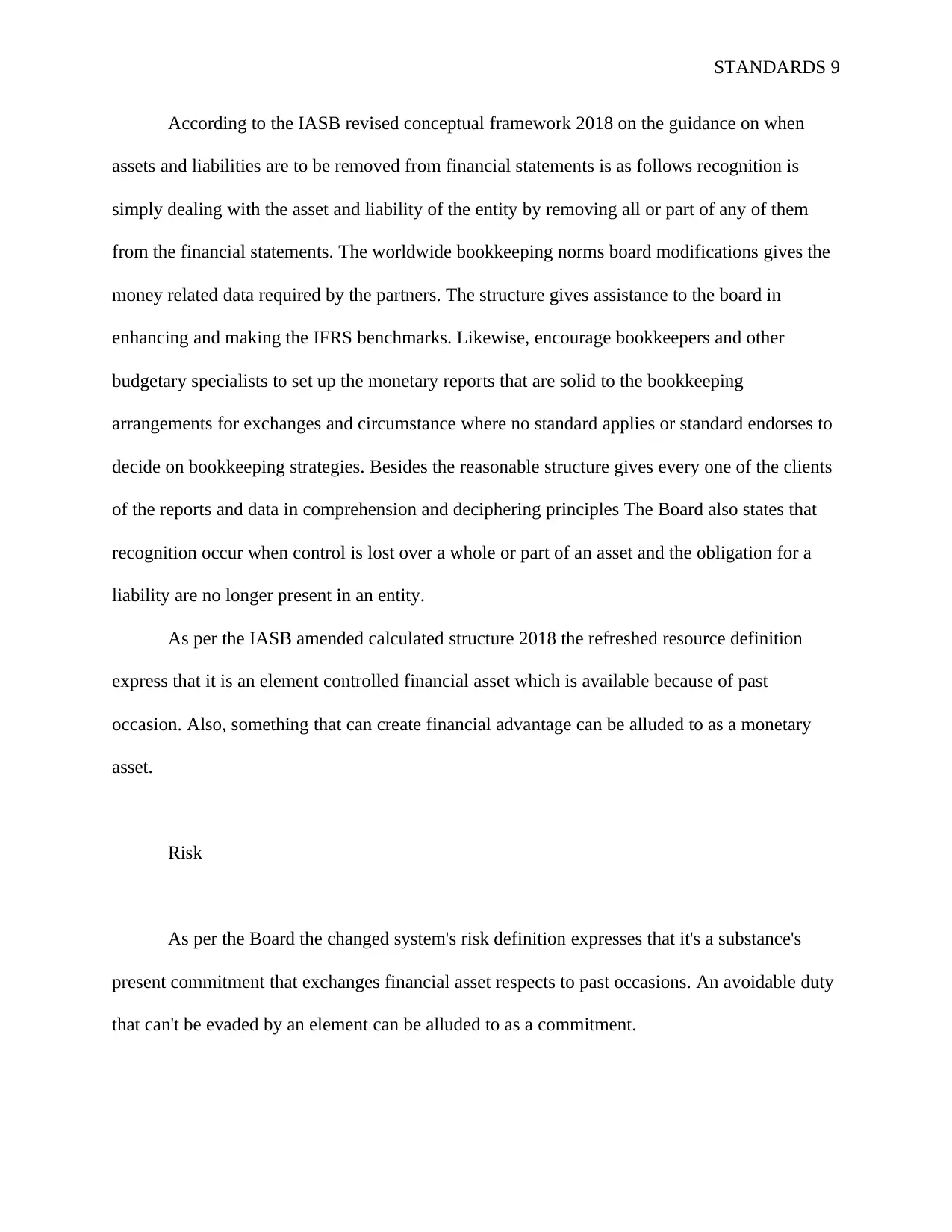
STANDARDS 9
According to the IASB revised conceptual framework 2018 on the guidance on when
assets and liabilities are to be removed from financial statements is as follows recognition is
simply dealing with the asset and liability of the entity by removing all or part of any of them
from the financial statements. The worldwide bookkeeping norms board modifications gives the
money related data required by the partners. The structure gives assistance to the board in
enhancing and making the IFRS benchmarks. Likewise, encourage bookkeepers and other
budgetary specialists to set up the monetary reports that are solid to the bookkeeping
arrangements for exchanges and circumstance where no standard applies or standard endorses to
decide on bookkeeping strategies. Besides the reasonable structure gives every one of the clients
of the reports and data in comprehension and deciphering principles The Board also states that
recognition occur when control is lost over a whole or part of an asset and the obligation for a
liability are no longer present in an entity.
As per the IASB amended calculated structure 2018 the refreshed resource definition
express that it is an element controlled financial asset which is available because of past
occasion. Also, something that can create financial advantage can be alluded to as a monetary
asset.
Risk
As per the Board the changed system's risk definition expresses that it's a substance's
present commitment that exchanges financial asset respects to past occasions. An avoidable duty
that can't be evaded by an element can be alluded to as a commitment.
According to the IASB revised conceptual framework 2018 on the guidance on when
assets and liabilities are to be removed from financial statements is as follows recognition is
simply dealing with the asset and liability of the entity by removing all or part of any of them
from the financial statements. The worldwide bookkeeping norms board modifications gives the
money related data required by the partners. The structure gives assistance to the board in
enhancing and making the IFRS benchmarks. Likewise, encourage bookkeepers and other
budgetary specialists to set up the monetary reports that are solid to the bookkeeping
arrangements for exchanges and circumstance where no standard applies or standard endorses to
decide on bookkeeping strategies. Besides the reasonable structure gives every one of the clients
of the reports and data in comprehension and deciphering principles The Board also states that
recognition occur when control is lost over a whole or part of an asset and the obligation for a
liability are no longer present in an entity.
As per the IASB amended calculated structure 2018 the refreshed resource definition
express that it is an element controlled financial asset which is available because of past
occasion. Also, something that can create financial advantage can be alluded to as a monetary
asset.
Risk
As per the Board the changed system's risk definition expresses that it's a substance's
present commitment that exchanges financial asset respects to past occasions. An avoidable duty
that can't be evaded by an element can be alluded to as a commitment.
⊘ This is a preview!⊘
Do you want full access?
Subscribe today to unlock all pages.

Trusted by 1+ million students worldwide
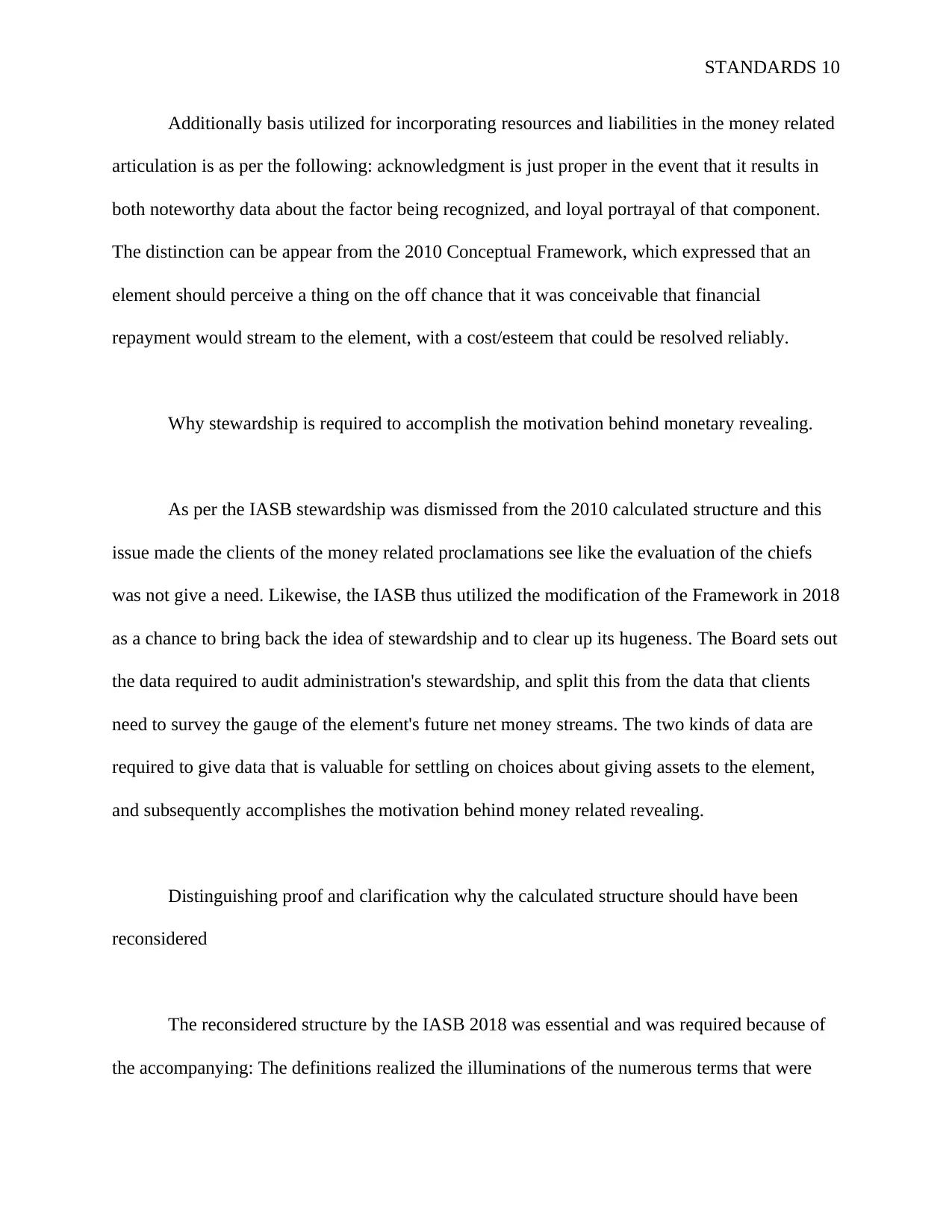
STANDARDS 10
Additionally basis utilized for incorporating resources and liabilities in the money related
articulation is as per the following: acknowledgment is just proper in the event that it results in
both noteworthy data about the factor being recognized, and loyal portrayal of that component.
The distinction can be appear from the 2010 Conceptual Framework, which expressed that an
element should perceive a thing on the off chance that it was conceivable that financial
repayment would stream to the element, with a cost/esteem that could be resolved reliably.
Why stewardship is required to accomplish the motivation behind monetary revealing.
As per the IASB stewardship was dismissed from the 2010 calculated structure and this
issue made the clients of the money related proclamations see like the evaluation of the chiefs
was not give a need. Likewise, the IASB thus utilized the modification of the Framework in 2018
as a chance to bring back the idea of stewardship and to clear up its hugeness. The Board sets out
the data required to audit administration's stewardship, and split this from the data that clients
need to survey the gauge of the element's future net money streams. The two kinds of data are
required to give data that is valuable for settling on choices about giving assets to the element,
and subsequently accomplishes the motivation behind money related revealing.
Distinguishing proof and clarification why the calculated structure should have been
reconsidered
The reconsidered structure by the IASB 2018 was essential and was required because of
the accompanying: The definitions realized the illuminations of the numerous terms that were
Additionally basis utilized for incorporating resources and liabilities in the money related
articulation is as per the following: acknowledgment is just proper in the event that it results in
both noteworthy data about the factor being recognized, and loyal portrayal of that component.
The distinction can be appear from the 2010 Conceptual Framework, which expressed that an
element should perceive a thing on the off chance that it was conceivable that financial
repayment would stream to the element, with a cost/esteem that could be resolved reliably.
Why stewardship is required to accomplish the motivation behind monetary revealing.
As per the IASB stewardship was dismissed from the 2010 calculated structure and this
issue made the clients of the money related proclamations see like the evaluation of the chiefs
was not give a need. Likewise, the IASB thus utilized the modification of the Framework in 2018
as a chance to bring back the idea of stewardship and to clear up its hugeness. The Board sets out
the data required to audit administration's stewardship, and split this from the data that clients
need to survey the gauge of the element's future net money streams. The two kinds of data are
required to give data that is valuable for settling on choices about giving assets to the element,
and subsequently accomplishes the motivation behind money related revealing.
Distinguishing proof and clarification why the calculated structure should have been
reconsidered
The reconsidered structure by the IASB 2018 was essential and was required because of
the accompanying: The definitions realized the illuminations of the numerous terms that were
Paraphrase This Document
Need a fresh take? Get an instant paraphrase of this document with our AI Paraphraser
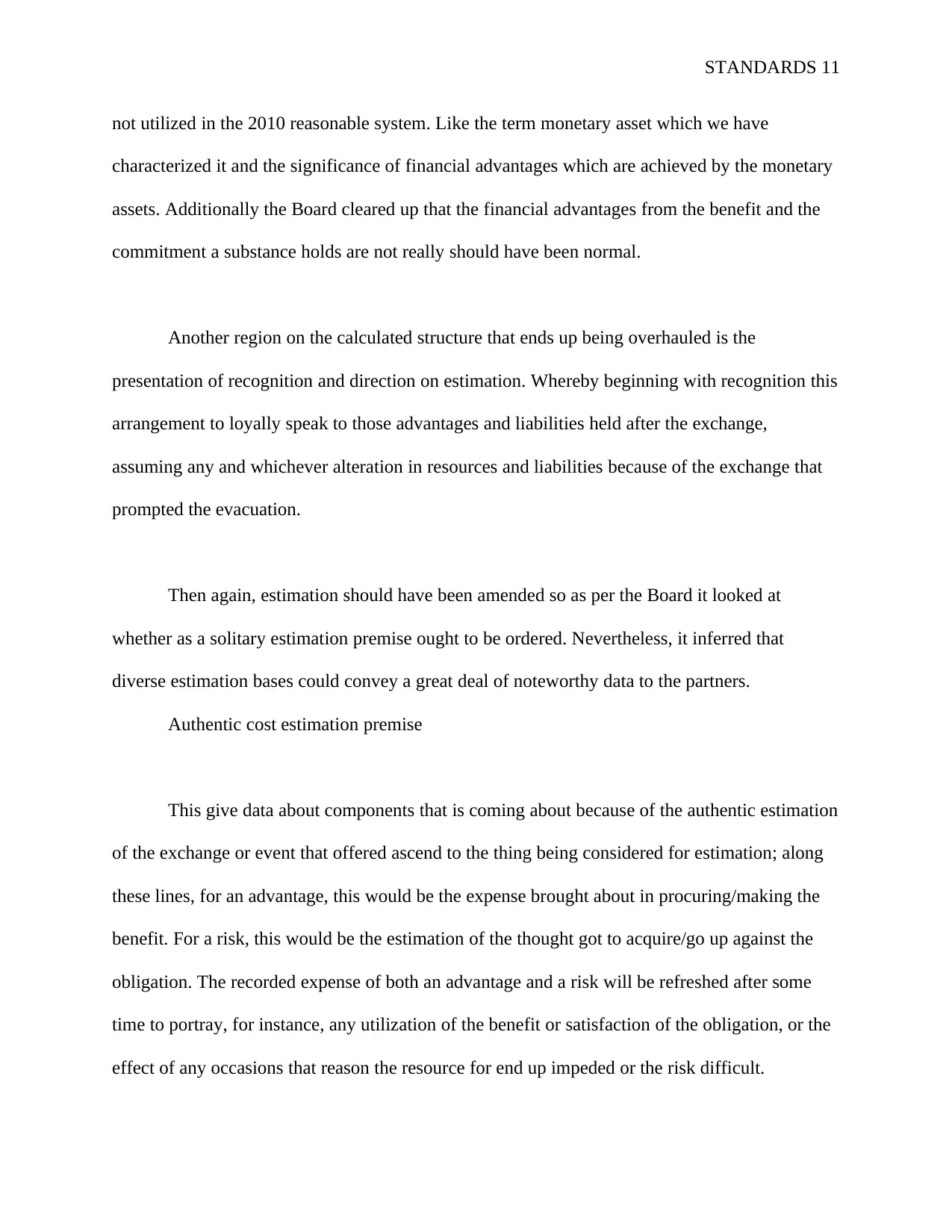
STANDARDS 11
not utilized in the 2010 reasonable system. Like the term monetary asset which we have
characterized it and the significance of financial advantages which are achieved by the monetary
assets. Additionally the Board cleared up that the financial advantages from the benefit and the
commitment a substance holds are not really should have been normal.
Another region on the calculated structure that ends up being overhauled is the
presentation of recognition and direction on estimation. Whereby beginning with recognition this
arrangement to loyally speak to those advantages and liabilities held after the exchange,
assuming any and whichever alteration in resources and liabilities because of the exchange that
prompted the evacuation.
Then again, estimation should have been amended so as per the Board it looked at
whether as a solitary estimation premise ought to be ordered. Nevertheless, it inferred that
diverse estimation bases could convey a great deal of noteworthy data to the partners.
Authentic cost estimation premise
This give data about components that is coming about because of the authentic estimation
of the exchange or event that offered ascend to the thing being considered for estimation; along
these lines, for an advantage, this would be the expense brought about in procuring/making the
benefit. For a risk, this would be the estimation of the thought got to acquire/go up against the
obligation. The recorded expense of both an advantage and a risk will be refreshed after some
time to portray, for instance, any utilization of the benefit or satisfaction of the obligation, or the
effect of any occasions that reason the resource for end up impeded or the risk difficult.
not utilized in the 2010 reasonable system. Like the term monetary asset which we have
characterized it and the significance of financial advantages which are achieved by the monetary
assets. Additionally the Board cleared up that the financial advantages from the benefit and the
commitment a substance holds are not really should have been normal.
Another region on the calculated structure that ends up being overhauled is the
presentation of recognition and direction on estimation. Whereby beginning with recognition this
arrangement to loyally speak to those advantages and liabilities held after the exchange,
assuming any and whichever alteration in resources and liabilities because of the exchange that
prompted the evacuation.
Then again, estimation should have been amended so as per the Board it looked at
whether as a solitary estimation premise ought to be ordered. Nevertheless, it inferred that
diverse estimation bases could convey a great deal of noteworthy data to the partners.
Authentic cost estimation premise
This give data about components that is coming about because of the authentic estimation
of the exchange or event that offered ascend to the thing being considered for estimation; along
these lines, for an advantage, this would be the expense brought about in procuring/making the
benefit. For a risk, this would be the estimation of the thought got to acquire/go up against the
obligation. The recorded expense of both an advantage and a risk will be refreshed after some
time to portray, for instance, any utilization of the benefit or satisfaction of the obligation, or the
effect of any occasions that reason the resource for end up impeded or the risk difficult.
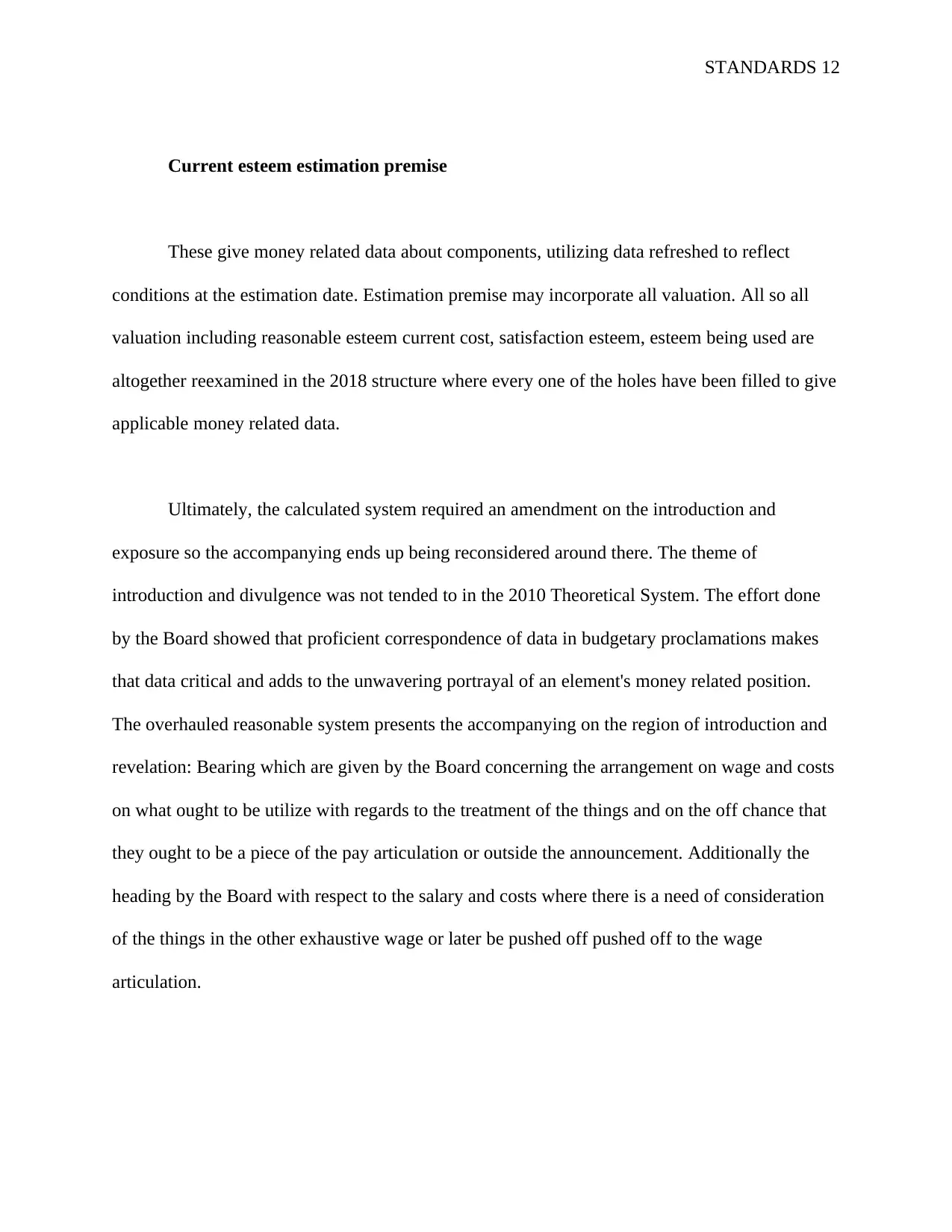
STANDARDS 12
Current esteem estimation premise
These give money related data about components, utilizing data refreshed to reflect
conditions at the estimation date. Estimation premise may incorporate all valuation. All so all
valuation including reasonable esteem current cost, satisfaction esteem, esteem being used are
altogether reexamined in the 2018 structure where every one of the holes have been filled to give
applicable money related data.
Ultimately, the calculated system required an amendment on the introduction and
exposure so the accompanying ends up being reconsidered around there. The theme of
introduction and divulgence was not tended to in the 2010 Theoretical System. The effort done
by the Board showed that proficient correspondence of data in budgetary proclamations makes
that data critical and adds to the unwavering portrayal of an element's money related position.
The overhauled reasonable system presents the accompanying on the region of introduction and
revelation: Bearing which are given by the Board concerning the arrangement on wage and costs
on what ought to be utilize with regards to the treatment of the things and on the off chance that
they ought to be a piece of the pay articulation or outside the announcement. Additionally the
heading by the Board with respect to the salary and costs where there is a need of consideration
of the things in the other exhaustive wage or later be pushed off pushed off to the wage
articulation.
Current esteem estimation premise
These give money related data about components, utilizing data refreshed to reflect
conditions at the estimation date. Estimation premise may incorporate all valuation. All so all
valuation including reasonable esteem current cost, satisfaction esteem, esteem being used are
altogether reexamined in the 2018 structure where every one of the holes have been filled to give
applicable money related data.
Ultimately, the calculated system required an amendment on the introduction and
exposure so the accompanying ends up being reconsidered around there. The theme of
introduction and divulgence was not tended to in the 2010 Theoretical System. The effort done
by the Board showed that proficient correspondence of data in budgetary proclamations makes
that data critical and adds to the unwavering portrayal of an element's money related position.
The overhauled reasonable system presents the accompanying on the region of introduction and
revelation: Bearing which are given by the Board concerning the arrangement on wage and costs
on what ought to be utilize with regards to the treatment of the things and on the off chance that
they ought to be a piece of the pay articulation or outside the announcement. Additionally the
heading by the Board with respect to the salary and costs where there is a need of consideration
of the things in the other exhaustive wage or later be pushed off pushed off to the wage
articulation.
⊘ This is a preview!⊘
Do you want full access?
Subscribe today to unlock all pages.

Trusted by 1+ million students worldwide
1 out of 13
Related Documents
Your All-in-One AI-Powered Toolkit for Academic Success.
+13062052269
info@desklib.com
Available 24*7 on WhatsApp / Email
![[object Object]](/_next/static/media/star-bottom.7253800d.svg)
Unlock your academic potential
Copyright © 2020–2025 A2Z Services. All Rights Reserved. Developed and managed by ZUCOL.





